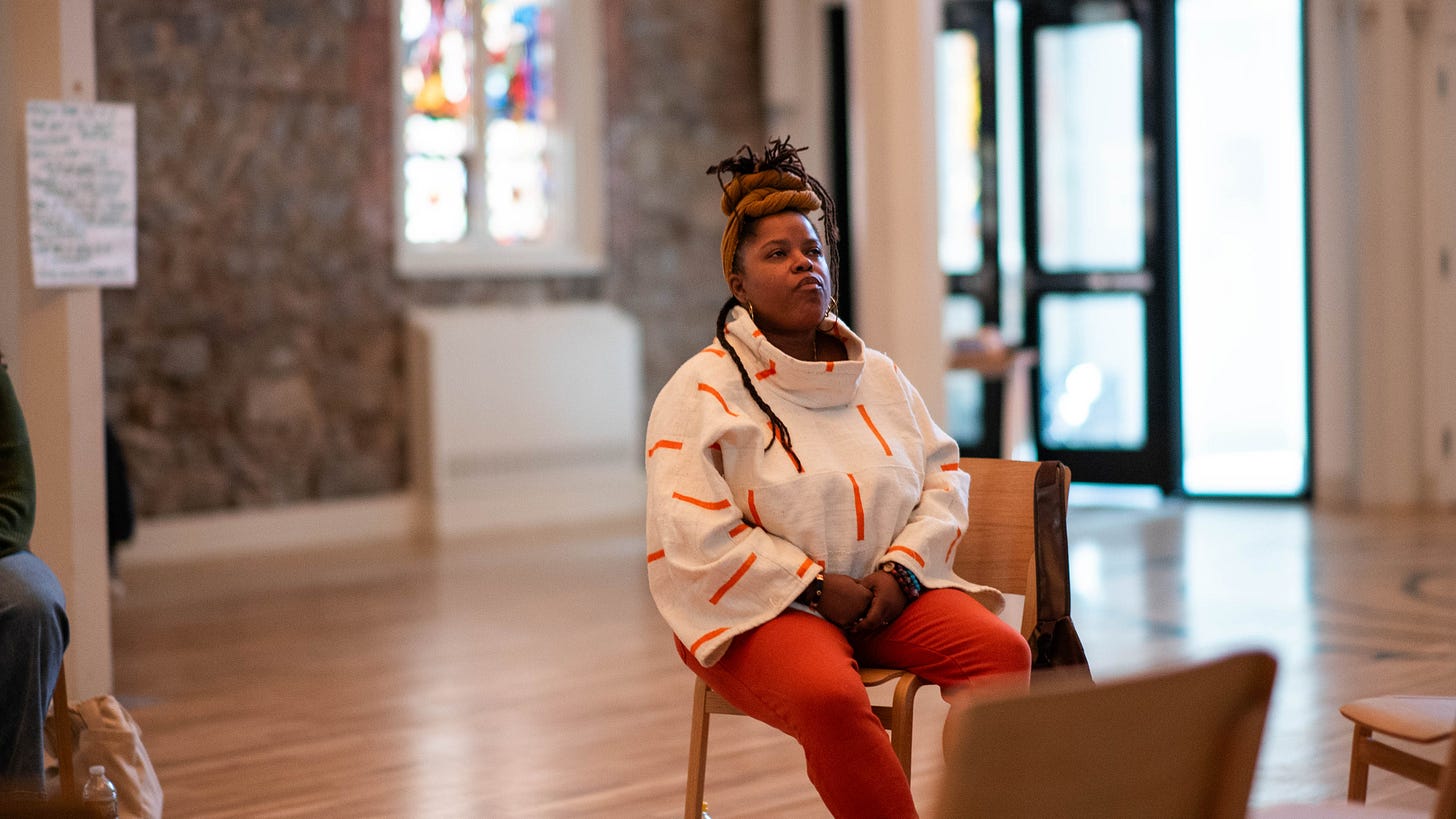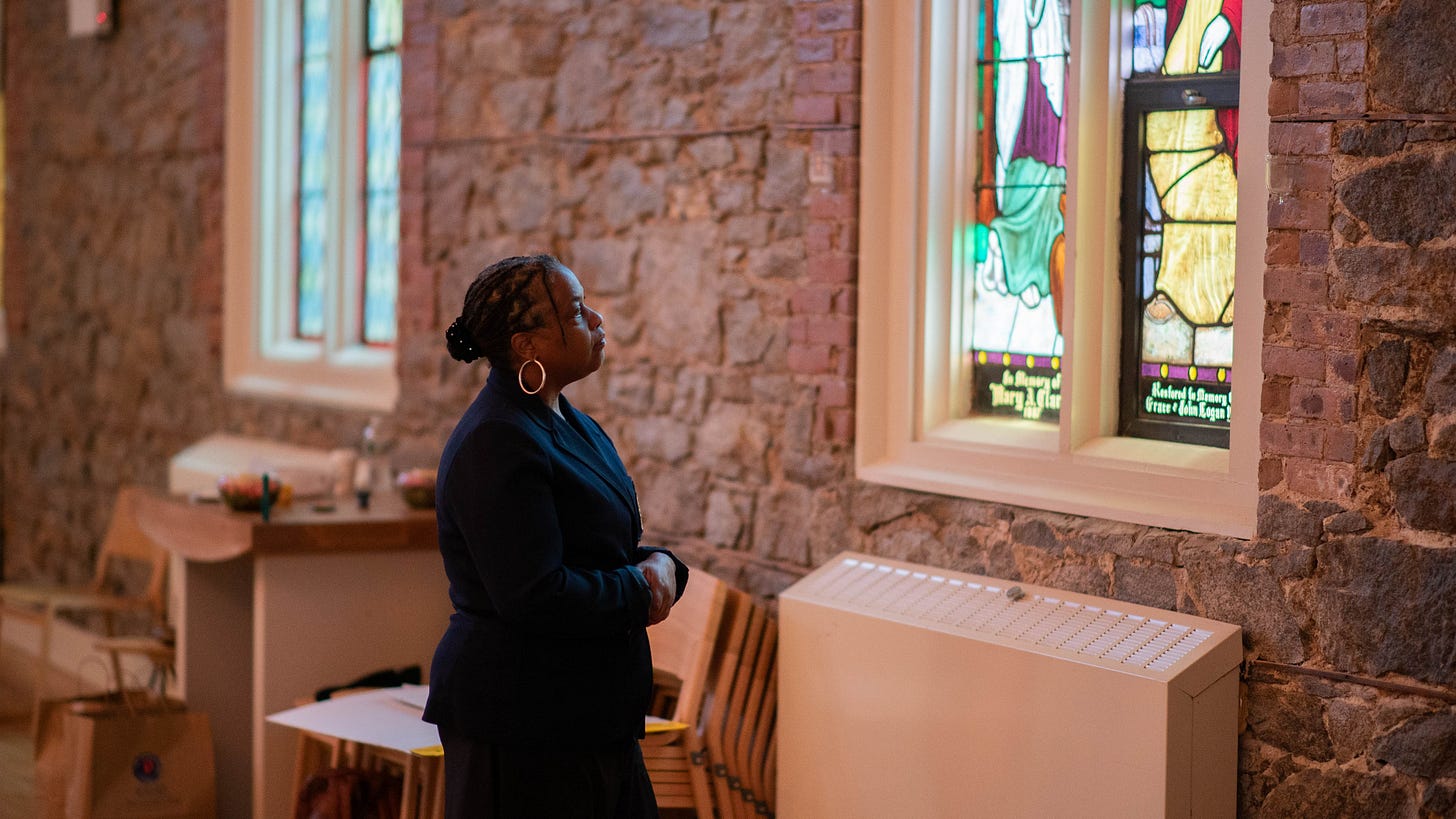Head up, chest out Silence,
I'm stressed out Shh, be quiet,
I'm stressed out
- Kendrick Lamar
Silence is of many kinds. There is a silence which is the prelude to prayer—the moment of hush and ingathering. There is a silence that tends to quiet the soundless words that fall from the tongue and to calm the noises of the mind and spirit. Every person who is concerned about the discipline of prayer must find the ministry of silence in accordance with his particular needs
- Howard Thurman
~~~~~~~~~~~~~~~~~~~~~~
For a recent sermon series at my church, Metro Hope Church in East Harlem, NY, we explored the tension between 'shouting & silence.' In preparing for this sermon, I was struck by the multifaceted nature of silence itself. Because I run around in contemplative circles, as I like to say, I started to understand the ongoing debate about the way we all center silence. It's not that we resist silence or anything like that; indeed, silence is a cornerstone of the Christian contemplative tradition, as well as of any meditative and mindfulness practices. It is what ultimately grounds and anchors all contemplative experience. Therefore, silence is a given. What became clear to me is that it doesn't have a single, let’s say monolithic understanding; rather, silence manifests in distinct ways, and there’s a debate in some contemplative spaces about what silence is and how we “get to it”.
In my sermon, I mentioned different ideas that relate to our understanding of silence. Even Howard Thurman, one of the most significant voices in Christian contemplation, presents perspectives that acknowledge both the value and the potential limitations of silence.
In one passage, he powerfully states, “Do not be silent; there is no limit to the power that may be released through you.” Yet, in another reflection, he offers a different lens: “It is out of the silence that all sounds come; it is in the stillness that the word is fashioned for the meaning it conveys.” Here, silence is the fertile ground for meaningful expression while in the former statement he was making sure that we use our voices to speak up.
This tension reminds me of Zora Neale Hurston's poignant observation: “If you are silent about your pain, they’ll kill you and say you enjoyed it.” which highlights the danger of a silence born of fear or powerlessness. However, in Their Eyes Were Watching God, she also portrays characters, particularly Janine, who embody a dignified silence, a quiet strength in the face of adversity that is anchored by a propensity towards silence.
I also recalled the words of Audre Lorde, who in “The Transformation of Silence into Language and Action,” echoes Zora Neale Hurston's earlier point, and warns us against the dangers of inaction: “My silences had not protected me. Your silence will not protect you.” underscoring the critical need to speak out against injustice. At the same time, Lorde recognized the transformative potential of inner stillness, observing, “In the breathless precision of silence one word is made.” Suggesting a generative form of silence, one that can give rise to purposeful action.
And so that led me to think about the different ways that silence can express itself in the world. There is complicit silence, the choice to remain silent out of self-interest or fear and just be complicit to evils happening all around us. There's also a more active silence, a powerful and dignified stillness in the face of oppression. And, of course, there's internal silence, the quietude we cultivate within.
These diverse forms of silence prompt crucial questions about their relationship with contemplation. In recent dialogues with folks in the contemplative movement, I've observed a primary emphasis on inner silence, the kind that nurtures introspection and engagement with our internal landscape. While inner silence is undeniably a central aspect of contemplation, as I mentioned earlier, I believe it points to two interconnected realities: first, there are numerous pathways to "enter into silence," each carrying its own unique implications and significance, and second, silence presents itself in diverse forms. This diversity underscores the fundamental question: what does "silence" truly mean in our movement?
It seems to me that within the contemplative movement, we often gravitate towards extremes in our understanding of silence. We tend to either equate true meditation with complete auditory silence, or conversely, dismiss practices that aren't silent in a specific way as not genuinely contemplative. I believe we need to critically examine and broaden our approaches to engaging with and inviting people into silence.
But what truly is silence? I propose defining what we can call ‘contemplative silence’ as an intentional and deliberate practice of connecting with ourselves, others, and the Divine to foster conscious contact with God. This silence serves to quiet the internal clamor of our minds, allowing us to discern the inner voice of the Divine deep within. It should cultivate profound reflection and introspection, ultimately leading to richer connections beyond ourselves – to our fellow beings, all of creation, and the Divine itself. I recognize this might seem like a lot, but I believe this is the essence of the silence we aspire to cultivate in contemplation. I believe that this 'contemplative silence' aligns with what Howard Thurman describes, and is also a concept echoed by Carmelite spiritual leaders and many countless Christian contemplatives.
And I think the pathways to contemplative silence are remarkably diverse. I believe a significant oversight within our movement is the lack of varied invitations into this stillness, this inner quiet. While simply sitting in silence is one avenue, we can be far more creative in how we guide people to cultivate it. I'm reminded of a friend and fellow member of the Community of the Incarnation who does contemplative work with justice-impacted individuals. She doesn't adhere to the traditional understanding of a silent practice involving only closed eyes and absolute quiet. Instead, she employs imaginative approaches, inviting people into an inner silence through a multitude of ways, though perhaps not all of which would be readily labeled "meditative" in some circles.The journey to inner quiet or silence can beautifully unfold through music, art, nature, and countless other avenues. While the destination remains an inner stillness, the approach can, and perhaps should, be uniquely tailored to each individual's experience and needs, especially for those carrying the weight of justice involvement. We just need to be more imaginative, and less rigid, when we think of how to bring people into silence.
Photo above and Cover Photo: Black Lives and Contemplation Retreat at the Church of the Ascension, Brookyln, NY, October 2024
It is crucial to embrace and acknowledge this diversity to dismantle harmful misconceptions held by some. Within certain contemplative spaces, there's a false and damaging assumption that Black people and other folks racialized as "of Color" are somehow inherently incapable of silence. As Kevin Quashie eloquently argues in The Sovereignty of Quiet, this is a racist notion that ignores the long history of silent practices within Black communities. It stems from a misunderstanding of the profound significance of silence, or as Quashie terms it, "quiet":
“Quiet, instead, is a metaphor for the full range of one’s inner life—one’s desires, ambitions, hungers, vulnerabilities, fears. The inner life is not apolitical or without social value, but neither is it determined entirely by publicness. In fact, the interior—dynamic and ravishing—is a stay against the dominance of the social world; it has its own sovereignty. It is hard to see, even harder to describe, but no less potent in its ineffability. In humanity, quiet is inevitable, essential. It is a simple, beautiful part of what it means to be alive. It is already there, if one is looking to understand it. An aesthetic of quiet is not incompatible with Black culture, but to notice and understand it requires a shift in how we read, what we look for, and what we expect, even what we remain open to. It requires paying attention in a different way.”
Quashie's insight highlights that this inner "quiet" is not an absence of something, but rather a rich and powerful space of self-possession and interiority, something often denied or overlooked in dominant narratives about Black experience. Therefore, offering diverse pathways into silence is not just about accessibility, but also about actively dismantling racist assumptions and honoring the inherent capacity for contemplative experience within all communities, but in order to do that we need to, as he suggests, pay attention in a different way.1
My own inclination leans towards the value of silence, or quiet, but it must be this contemplative, dynamic silence, one that is not a passive acceptance of injustice. Instead, it should be a silence that delves into our inner being, fostering a connection with the divine and preparing us for both thoughtful action and necessary vocalization.
Silence also plays a crucial role in fostering meaningful connection with others. To truly learn from one another with an open and trusting heart, we must be willing to embrace silence together. As Howard Thurman quotes Maurice Maeterlinck in The Inward Journey: “We do not know each other yet, we have not dared to be silent together.”
Thurman reflects on this profound insight, noting, “It is no small wonder that man tends to worship the sound of his voice and to give it an authority greater than anything that remains when all words have been said. … Silence is not trusted.” Despite our ingrained tendency to fill every space with our own voices, Thurman reminds us of the power of silence in relationships: “If it be indeed your desire to give yourself over to another, be silent.”
Ultimately, to cultivate this contemplative silence, or a quiet, that feels safe and accessible for everyone, that can be used for us to connect with others, that can connect us with the Divine, we must intentionally create supportive environments to guide people toward it. Considering the rich diversity of contemplative traditions, shouldn't we be leveraging that diversity to invite people into silence in more varied ways? I definitely think so.
If you are looking for more ways into silence in your own contemplative practice, come join us in person at the Cathedral of the Incarnation (36 Cathedral Ave, Garden City, NY 11530) on Tuesday, April 29th at 7 pm ET for a spectacular “Meditation Under the Moon”. For more info, including our livestream link, click here.
Guesnerth Josué Perea just completed his final year of the Novitiate with the Community of the Incarnation, the New Monastic Community that runs the Center for Spiritual Imagination. He is also the executive director of the afrolatin@ forum, founder and co-curator of the AfoLatine Theology Project, associate pastor of Metro Hope Church, and co-host of the Majestad Prieta Podcast. His research on AfroLatinidad has been part of various publications including Let Spirit Speak: Cultural Journeys through the African Diaspora and the Revista de Estudios Colombianos. He is the Executive Producer of the new documentary short Faith in Blackness: An Exploration of AfroLatine Spirituality.
While Kevin Quashie thoughtfully distinguishes between "quiet" and "silence," and I concur with his nuanced understanding, for the purpose of this piece, I am drawing upon his articulation of "quiet" as a lens through which to understand the intended meaning of "silence" within the contemplative movement.







